check engine FIAT ULYSSE 2007 2.G User Guide
[x] Cancel search | Manufacturer: FIAT, Model Year: 2007, Model line: ULYSSE, Model: FIAT ULYSSE 2007 2.GPages: 254, PDF Size: 3.42 MB
Page 141 of 254
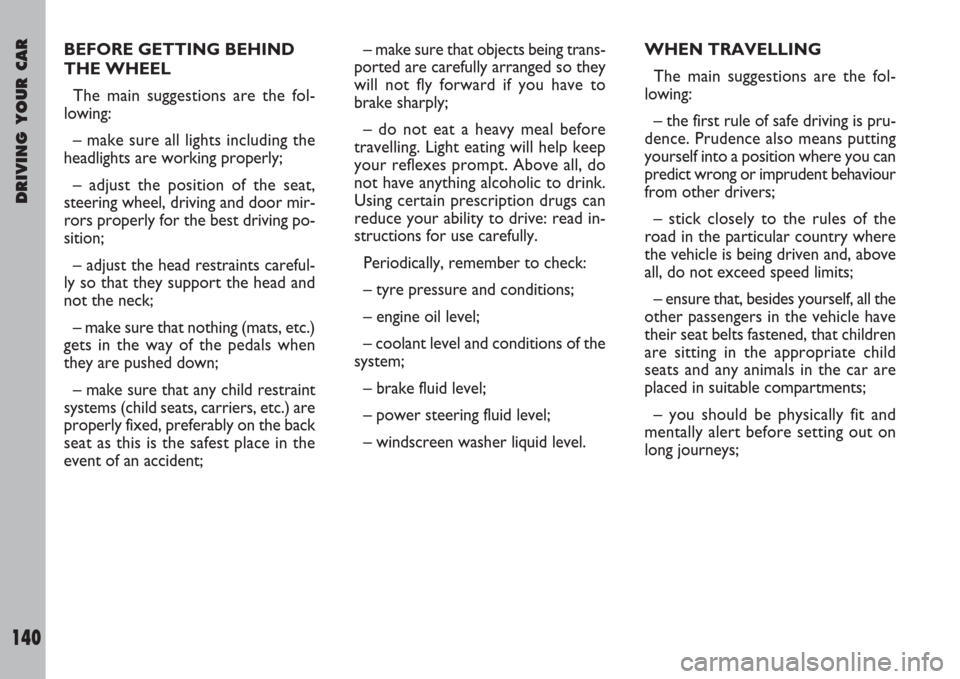
DRIVING YOUR CAR
140
BEFORE GETTING BEHIND
THE WHEEL
The main suggestions are the fol-
lowing:
– make sure all lights including the
headlights are working properly;
– adjust the position of the seat,
steering wheel, driving and door mir-
rors properly for the best driving po-
sition;
– adjust the head restraints careful-
ly so that they support the head and
not the neck;
– make sure that nothing (mats, etc.)
gets in the way of the pedals when
they are pushed down;
– make sure that any child restraint
systems (child seats, carriers, etc.) are
properly fixed, preferably on the back
seat as this is the safest place in the
event of an accident;– make sure that objects being trans-
ported are carefully arranged so they
will not fly forward if you have to
brake sharply;
– do not eat a heavy meal before
travelling. Light eating will help keep
your reflexes prompt. Above all, do
not have anything alcoholic to drink.
Using certain prescription drugs can
reduce your ability to drive: read in-
structions for use carefully.
Periodically, remember to check:
– tyre pressure and conditions;
– engine oil level;
– coolant level and conditions of the
system;
– brake fluid level;
– power steering fluid level;
– windscreen washer liquid level.WHEN TRAVELLING
The main suggestions are the fol-
lowing:
– the first rule of safe driving is pru-
dence. Prudence also means putting
yourself into a position where you can
predict wrong or imprudent behaviour
from other drivers;
– stick closely to the rules of the
road in the particular country where
the vehicle is being driven and, above
all, do not exceed speed limits;
– ensure that, besides yourself, all the
other passengers in the vehicle have
their seat belts fastened, that children
are sitting in the appropriate child
seats and any animals in the car are
placed in suitable compartments;
– you should be physically fit and
mentally alert before setting out on
long journeys;
Page 148 of 254
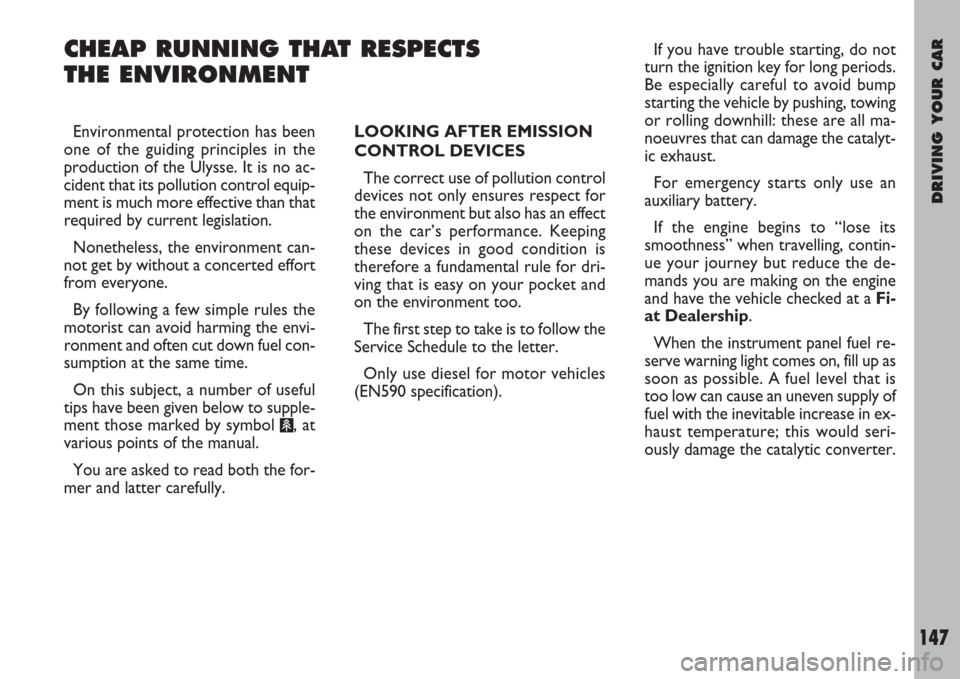
DRIVING YOUR CAR
147
CHEAP RUNNING THAT RESPECTS
THE ENVIRONMENT
LOOKING AFTER EMISSION
CONTROL DEVICES
The correct use of pollution control
devices not only ensures respect for
the environment but also has an effect
on the car’s performance. Keeping
these devices in good condition is
therefore a fundamental rule for dri-
ving that is easy on your pocket and
on the environment too.
The first step to take is to follow the
Service Schedule to the letter.
Only use diesel for motor vehicles
(EN590 specification). Environmental protection has been
one of the guiding principles in the
production of the Ulysse. It is no ac-
cident that its pollution control equip-
ment is much more effective than that
required by current legislation.
Nonetheless, the environment can-
not get by without a concerted effort
from everyone.
By following a few simple rules the
motorist can avoid harming the envi-
ronment and often cut down fuel con-
sumption at the same time.
On this subject, a number of useful
tips have been given below to supple-
ment those marked by symbol
#, at
various points of the manual.
You are asked to read both the for-
mer and latter carefully.If you have trouble starting, do not
turn the ignition key for long periods.
Be especially careful to avoid bump
starting the vehicle by pushing, towing
or rolling downhill: these are all ma-
noeuvres that can damage the catalyt-
ic exhaust.
For emergency starts only use an
auxiliary battery.
If the engine begins to “lose its
smoothness” when travelling, contin-
ue your journey but reduce the de-
mands you are making on the engine
and have the vehicle checked at a Fi-
at Dealership.
When the instrument panel fuel re-
serve warning light comes on, fill up as
soon as possible. A fuel level that is
too low can cause an uneven supply of
fuel with the inevitable increase in ex-
haust temperature; this would seri-
ously damage the catalytic converter.
Page 152 of 254

DRIVING YOUR CAR
151
STORING THE CAR
The following precautions should be
taken if the car will not be used for
several months:
– park the vehicle in covered, dry and
if possible well-ventilated premises;
– engage a gear (Pfor versions with
automatic electronic gear);
– make sure the handbrake is not en-
gaged;
– clean and protect the painted parts
using protective wax;
– sprinkle talcum powder on the rub-
ber windscreen and rear window
wiper blades and lift them off the glass;
– slightly open the windows;
– inflate the tyres to 0.5 bar above
the normal specified pressure and
check it at intervals;– switch off the electronic car alarm;
– disconnect the terminals (–) from
the battery poles (negative pole first)
and check the battery charge. When
the vehicle is in storage, this check
should be carried out once a month.
If no-load voltage is less than 12.5V,
recharge the battery;
– do not drain the engine cooling sys-
tem;
– cover the vehicle with a cloth or
perforated plastic sheet. Do not use
sheets of non-perforated plastic as
they do not allow moisture on the car
body to evaporate.RESTARTING THE CAR
AFTER STORAGE
Before restarting the vehicle after a
long storage, make the following op-
erations:
– do not take dust off the bodywork
without water;
– check if there are fluid leakages (oil,
brake and clutch fluid, engine coolant,
etc.);
– have the engine oil and the filter re-
placed;
– check the level of: brake and clutch
fluid, engine coolant;
Page 153 of 254
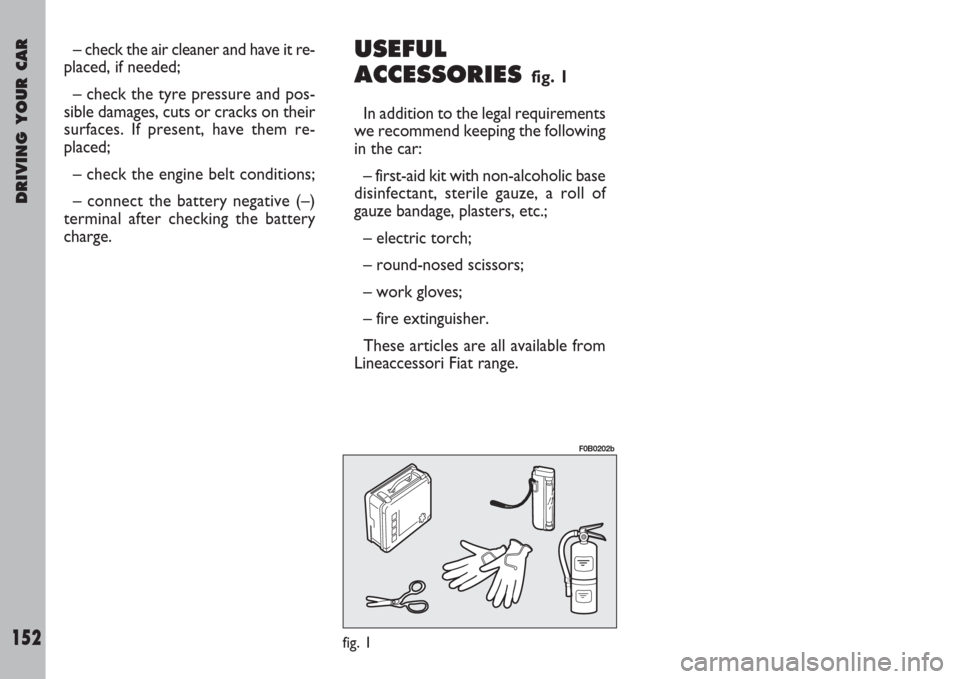
DRIVING YOUR CAR
152
USEFUL
ACCESSORIES
fig. 1
In addition to the legal requirements
we recommend keeping the following
in the car:
– first-aid kit with non-alcoholic base
disinfectant, sterile gauze, a roll of
gauze bandage, plasters, etc.;
– electric torch;
– round-nosed scissors;
– work gloves;
– fire extinguisher.
These articles are all available from
Lineaccessori Fiat range.
fig. 1
F0B0202b
– check the air cleaner and have it re-
placed, if needed;
– check the tyre pressure and pos-
sible damages, cuts or cracks on their
surfaces. If present, have them re-
placed;
– check the engine belt conditions;
– connect the battery negative (–)
terminal after checking the battery
charge.
Page 156 of 254

IN AN EMERGENCY
155
An incorrectly posi-
tioned jack may cause the
vehicle to fall. Do not use
the jack to lift loads exceeding
that indicated on the label at-
tached to the jack itself.Do not lubricate the bolt
threads before fitting
them back: they could
come loose.
Never start the engine when the
vehicle is jacked up.
If you are towing a trailer, re-
move the trailer before jacking
up the vehicle.Never tamper with the
inflation valve. Never
place tools between the
rim and the tyre.
Check the tyre and space-saver
spare wheel pressure regularly.
The tyre inflation pressure is
shown in the “Technical specifi-
cations” chapter.
The jack should only be
used to change a wheel
on the vehicle for which it
was designed. It should not be put
to other uses or employed to
raise other models. Under no cir-
cumstances should it be used
when carrying out repairs under
the vehicle.
Check the inflation pres-
sure of the tyres and the
spare wheel regularly. If
you change the type of wheels (al-
loy rims instead of steel rims) you
will have to change the entire set
of fastening bolts with another
set of suitably sized bolts.
You should keep the bolts in
case you decide to use the origi-
nal type of wheel later on.Signal the presence of
the stopped car according
to the laws in force: haz-
ard lights, reflecting triangle, etc.
Any passengers on board should
leave the car, especially if it is
heavily laden. Passengers should
stay away from oncoming traffic
while the wheel is being changed.
If the wheel is being changed on
a steep or badly surfaced road,
place wedges or other suitable
material under the wheels to
stop the car.
GENERAL INSTRUCTIONS
Observe the instructions on this and
the following pages to use the jack and
space-saver spare wheel correctly.
Page 172 of 254
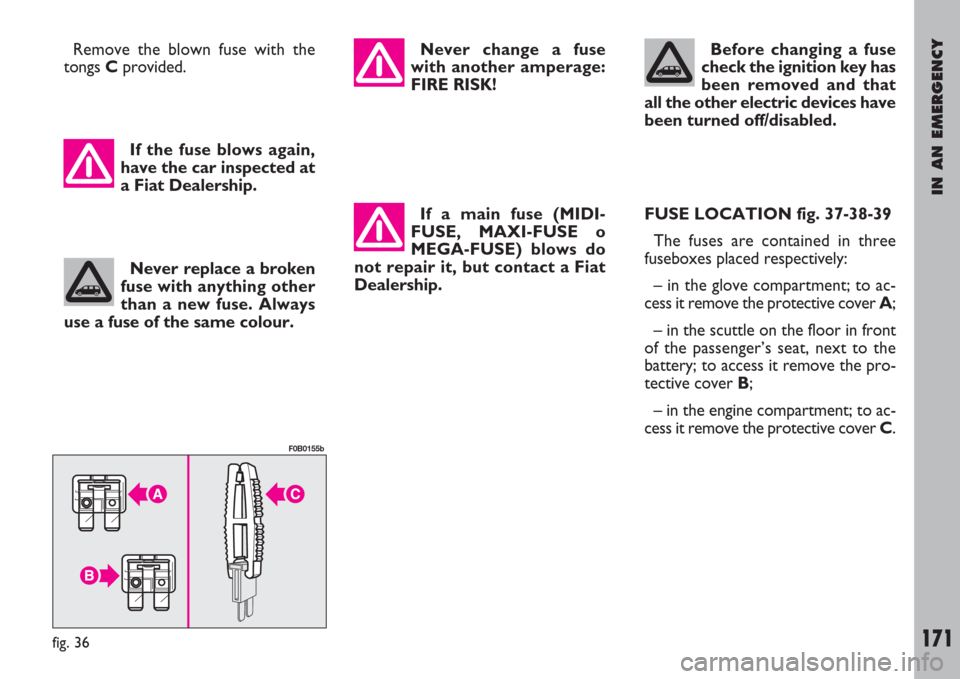
IN AN EMERGENCY
171
Remove the blown fuse with the
tongs Cprovided.
If a main fuse (MIDI-
FUSE, MAXI-FUSE o
MEGA-FUSE) blows do
not repair it, but contact a Fiat
Dealership.FUSE LOCATION fig. 37-38-39
The fuses are contained in three
fuseboxes placed respectively:
– in the glove compartment; to ac-
cess it remove the protective cover A;
– in the scuttle on the floor in front
of the passenger’s seat, next to the
battery; to access it remove the pro-
tective cover B;
– in the engine compartment; to ac-
cess it remove the protective cover C. Never replace a broken
fuse with anything other
than a new fuse. Always
use a fuse of the same colour.Before changing a fuse
check the ignition key has
been removed and that
all the other electric devices have
been turned off/disabled.Never change a fuse
with another amperage:
FIRE RISK!
fig. 36
F0B0155b
If the fuse blows again,
have the car inspected at
a Fiat Dealership.
Page 186 of 254
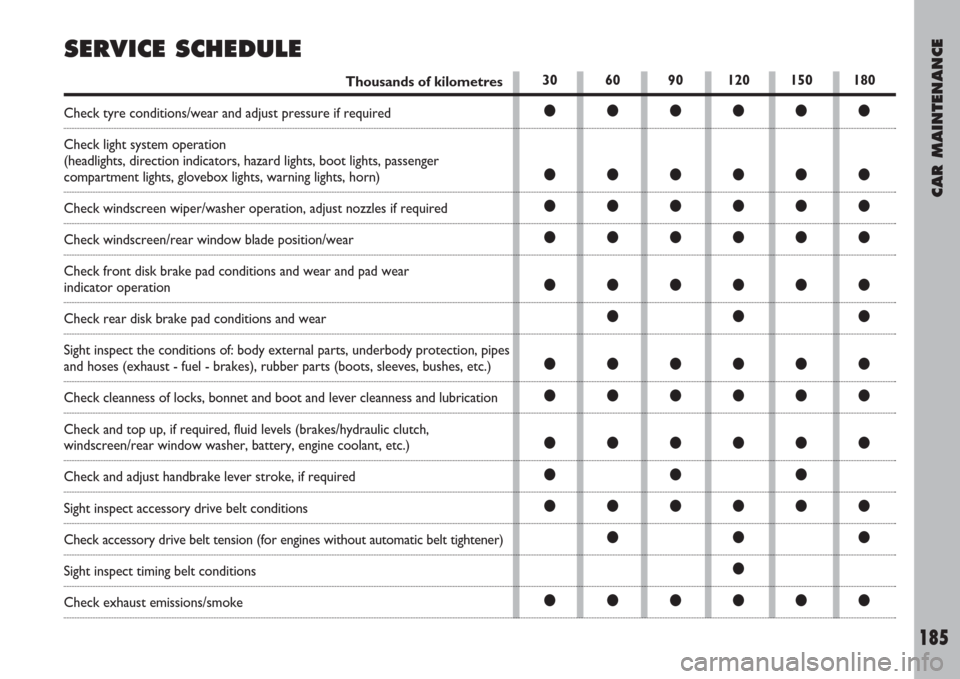
SERVICE SCHEDULE
30 60 90 120 150 180
●●●●●●
●●●●●●
●●●●●●
●●●●●●
●●●●●●
●●●
●●●●●●
●●●●●●
●●●●●●
●●●
●●●●●●
●●●
●
●●●●●●
CAR MAINTENANCE
185
Thousands of kilometres
Check tyre conditions/wear and adjust pressure if required
Check light system operation
(headlights, direction indicators, hazard lights, boot lights, passenger
compartment lights, glovebox lights, warning lights, horn)
Check windscreen wiper/washer operation, adjust nozzles if required
Check windscreen/rear window blade position/wear
Check front disk brake pad conditions and wear and pad wear
indicator operation
Check rear disk brake pad conditions and wear
Sight inspect the conditions of: body external parts, underbody protection, pipes
and hoses (exhaust - fuel - brakes), rubber parts (boots, sleeves, bushes, etc.)
Check cleanness of locks, bonnet and boot and lever cleanness and lubrication
Check and top up, if required, fluid levels (brakes/hydraulic clutch,
windscreen/rear window washer, battery, engine coolant, etc.)
Check and adjust handbrake lever stroke, if required
Sight inspect accessory drive belt conditions
Check accessory drive belt tension (for engines without automatic belt tightener)
Sight inspect timing belt conditions
Check exhaust emissions/smoke
Page 187 of 254
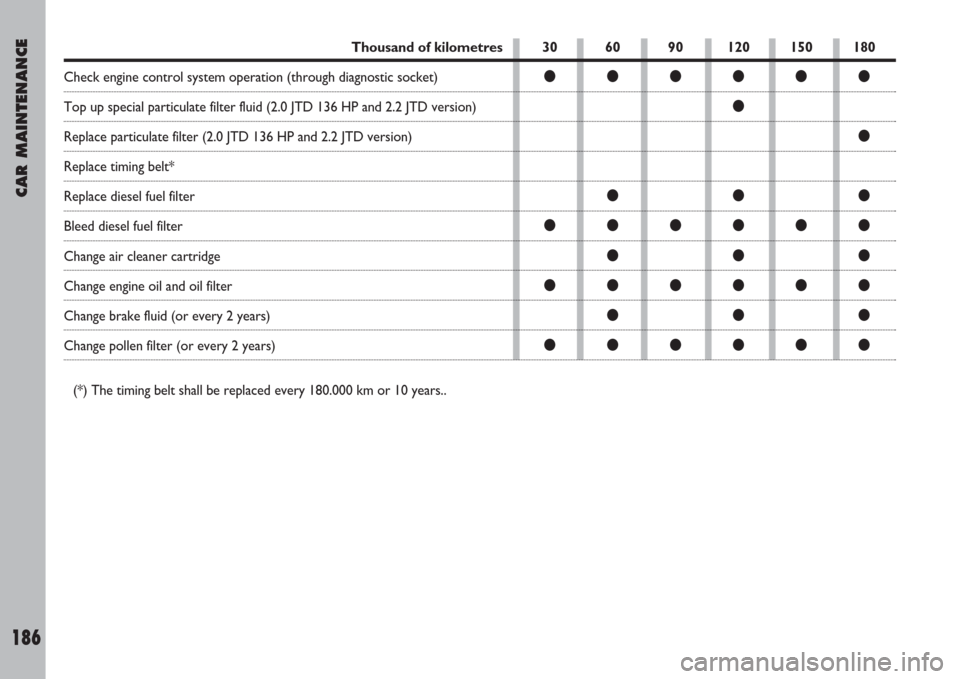
30 60 90 120 150 180
●●●●●●
●
●
●●●
●●●●●●
●●●
●●●●●●
●●●
●●●●●●
CAR MAINTENANCE
186
Thousand of kilometres
Check engine control system operation (through diagnostic socket)
Top up special particulate filter fluid (2.0 JTD 136 HP and 2.2 JTD version)
Replace particulate filter (2.0 JTD 136 HP and 2.2 JTD version)
Replace timing belt*
Replace diesel fuel filter
Bleed diesel fuel filter
Change air cleaner cartridge
Change engine oil and oil filter
Change brake fluid (or every 2 years)
Change pollen filter (or every 2 years)
(*) The timing belt shall be replaced every 180.000 km or 10 years..
Page 188 of 254
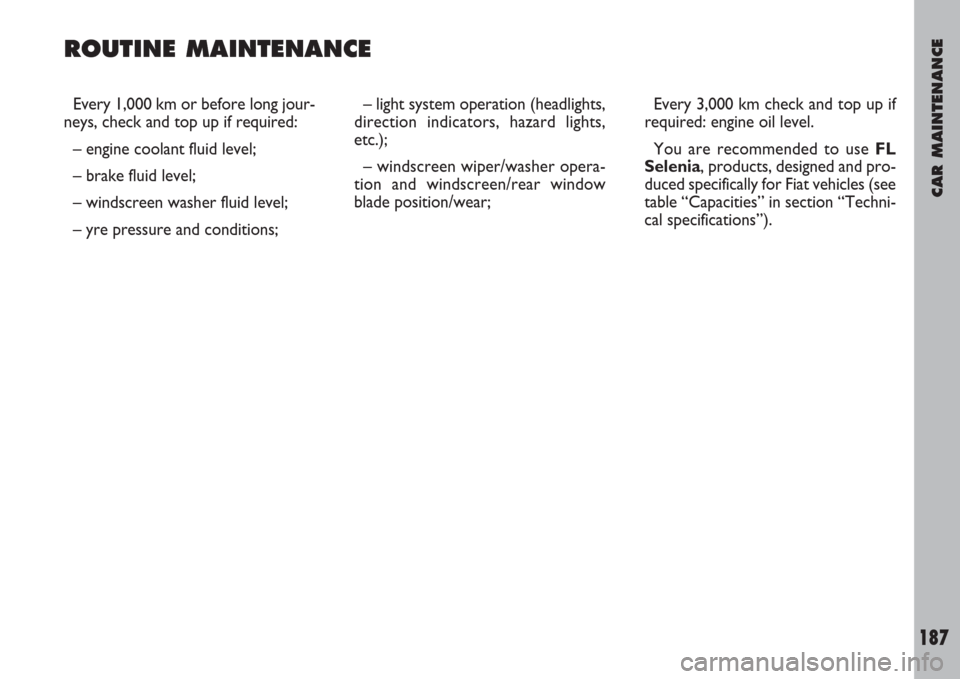
CAR MAINTENANCE
187
Every 1,000 km or before long jour-
neys, check and top up if required:
– engine coolant fluid level;
– brake fluid level;
– windscreen washer fluid level;
– yre pressure and conditions;– light system operation (headlights,
direction indicators, hazard lights,
etc.);
– windscreen wiper/washer opera-
tion and windscreen/rear window
blade position/wear;Every 3,000 km check and top up if
required: engine oil level.
You are recommended to use FL
Selenia, products, designed and pro-
duced specifically for Fiat vehicles (see
table “Capacities” in section “Techni-
cal specifications”).
ROUTINE MAINTENANCE
Page 189 of 254
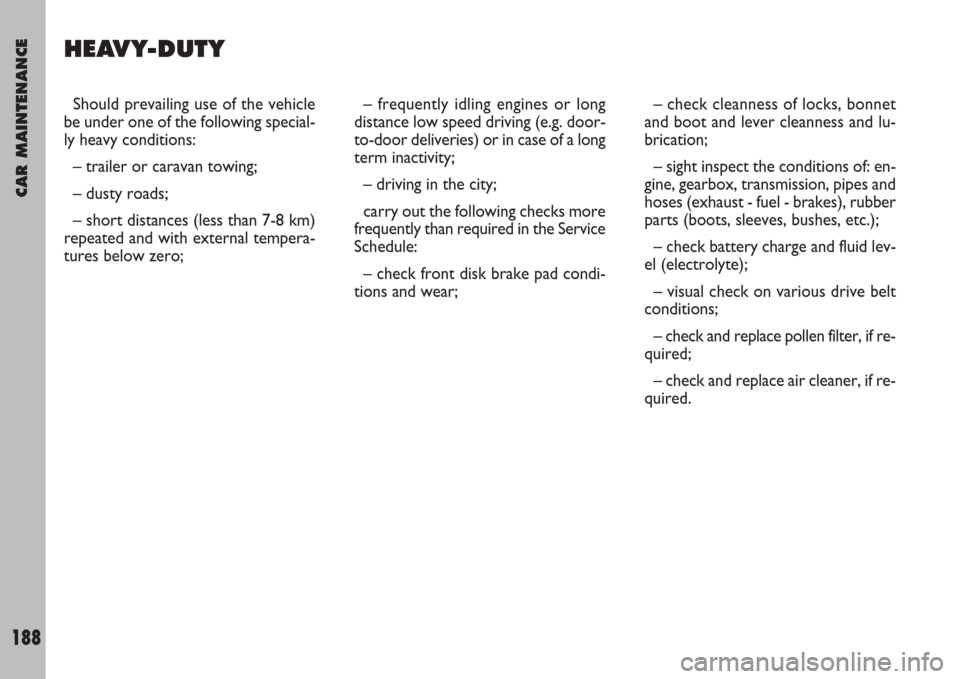
CAR MAINTENANCE
188
Should prevailing use of the vehicle
be under one of the following special-
ly heavy conditions:
– trailer or caravan towing;
– dusty roads;
– short distances (less than 7-8 km)
repeated and with external tempera-
tures below zero;– frequently idling engines or long
distance low speed driving (e.g. door-
to-door deliveries) or in case of a long
term inactivity;
– driving in the city;
carry out the following checks more
frequently than required in the Service
Schedule:
– check front disk brake pad condi-
tions and wear;– check cleanness of locks, bonnet
and boot and lever cleanness and lu-
brication;
– sight inspect the conditions of: en-
gine, gearbox, transmission, pipes and
hoses (exhaust - fuel - brakes), rubber
parts (boots, sleeves, bushes, etc.);
– check battery charge and fluid lev-
el (electrolyte);
– visual check on various drive belt
conditions;
– check and replace pollen filter, if re-
quired;
– check and replace air cleaner, if re-
quired.
HEAVY-DUTY